Every so often, a paradigm shift occurs, and the sportbike segment is positively percolating with change. These things come in cycles, with one manufacturer pushing the envelope and others following suit. Rigid displacement doctrine, expected features, and pricing are all being rethought with the 2023 Kawasaki Ninja ZX-4RR and Yamaha YZF-R7—two motorcycles that apply wildly different schools of thought when answering the supersport question.
The ZX-4RR is easily 2023’s biggest shock of the model year, tugging at the heartstrings of many a veteran rider with a nod to the legendary 400-class motorcycles of yesteryear. Every manufacturer under the rising sun told us the 400s were too costly, there was no market for them, and it’d never happen—but arithmetic finally panned out. We’d be remiss to not cite Yamaha as the first to reshape its sport philosophy, as the R7 has effectively replaced the now-track-only YZF-R6.
The rules are going out the window, folks. To quote the venerable Dr. Peter Venkman, “Human sacrifice, dogs and cats living together—mass hysteria!” doesn’t seem too farfetched a reaction from our dear readers when they see Kawasaki’s stratospheric-revving 399cc inline-four sportbike and Yamaha’s torque-rich 649cc parallel-twin propelled motorcycle paired up.
Look past the cylinder count, because when we peruse empirical data, it’s clear that these two motorcycles have been peaking at each other’s homework. Both bikes tip the scales at an identical claimed 414 pounds with a filled fuel tank; their geometry figures are within earshot of one another—the Kawi’s 23.5-degree rake and 3.8 inches of trail nearly mirror the Yamaha’s 23.7-degree/3.5-inch figures. The same can be said of their respective wheelbases, with the Kawasaki measuring shorter at 54.3 inches while the Yamaha has a slightly longer 54.9-inch gait. Peak horsepower in the mid-60s, though, as we’ll soon discuss, their torque figures are quite different. That’s all to say that any teacher’s assistant worth their salt would look at these spec sheets and raise an eyebrow.
Even their respective MSRPs sit close to one another, with the p-twin-wielding Yamaha raising its hand at attention via its $9199 price tag while the four-cylinder-powered Kawasaki comes in $500 higher at $9699. As the newest kid on the block, we can expect the Kawasaki to demand extra milk money because inflation is problematic for everyone (the RR KRT’s price goes up $400 for ’24; no word on the R7’s 2024 MSRP).
Still, those extra five bills fund some additional features. The ZX-4RR has a proven TFT display with ride modes and Bluetooth connectivity, compared to the R7 basic LCD dash. Adjustable traction control is featured on the green bike and not offered on the blue one (err…white in this case). Also, the Kawasaki’s quickshifter works in either direction, while the Yamaha is up-only and a $200 option. Lastly, the Kawi’s overall fit-and-finish angles for extra credit.
Sharpen Your #2 Pencils: Your Test Begins Now
Any proper comparison test needs guidelines and accommodations met for all parties. For that, we headed to the tight and technical 1.6-mile course known as Streets of Willow Springs at Willow Springs International Raceway, which is arguably the best playground in Southern California for these two machines.
We joined up with Compact Octane, a relatively new track day organization that focuses on 400cc and smaller displacement motorcycles, creating a safe space for little bikes to frolic among their corner-speed-loving cohorts. Everyone is welcome, from beginners to veteran racers looking to hone their craft. There’s an open class for bikes of every other displacement—inclusion and diversity, children—let the holding of hands and singing of Kumbaya commence!
In stock trim, our U.S.-spec 2023 Kawasaki Ninja ZX-4RR featured an EPA noise-emissions restricted tune that prematurely curbs its peak power at 11,500 rpm—leaving around 20 horsepower on the table. That certainly isn’t how Kawasaki or the riding public intended the wee screamer to be, so we rectified this indignity with the help of Graves Motorsports, which just so happens to offer ECU flashing for these models and many others.
Our one-stop SoCal-based speed shop’s tune not only raises the redline above a whopping 16,000 rpm, but allows the Kawasaki to pump out 68.7 horsepower at 15,000 rpm and 24.9 ft-lbs of torque at 12,200 rpm on the dyno. To keep things on an even keel, we also flashed the Yamaha. The twin put out 64.4 horsepower at 8700 rpm and 44.6 ft-lbs of torque at 6400 rpm at the rear wheel. That didn’t reflect any meaningful performance gains on the dyno sheet, though throttle response is improved.
The dyno illustrates two realities—the stock 4RR powerplant is heavily restricted electronically, whereas the R7’s longstanding CP2 engine, borrowed from the established MT-07, passes emissions with flying colors.
What applies to either bike is that you’ll need to add bolt-on parts to realize greater performance gains, including high-flow air cleaners, full exhaust systems, velocity stacks, and the like. Conveniently, Graves and many other tuners offer all those aforementioned go-fast parts.
Now, here is the disclaimer and the crux of our track-only test. While reflashing is common in the sportbike community, it could mean your motorcycle is no longer EPA-compliant or street-legal. Those who continue to ride modified motorcycles on public roads can be subject to fines or penalties, and in some cases, tuners may also be found liable by Big Brother. Graves Motorsports makes it abundantly clear that its tunes are only to be used on closed courses, such as the Streets of Willow. As tempted as we were, we never ran them on the street.
Finally, we chose the Dunlop Sportmax Q5 as a control tire for a few simple reasons. First, these sporty tires offer an impressive grip with exceedingly quick warmup times, meaning we can ditch the tire warmers, stands, and generators. While that’s a massive plus in our book, the Q5 is one of the few tires on the market supporting both bikes’ OE sizing: The 120/70-17 fronts are plentiful from a variety of manufacturers, but as we move rearward, the story differs. The Kawasaki opts for a narrower and taller 160/60-17 rear, while the Yamaha uses an ordinary 180/55-17 rear. With our busy work cleared, it’s time for our multi-session exam to begin.
Theories In Motion
Stark contrasts are a reoccurring theme in this comparison test, and there’s no more significant division in philosophies when discussing these two powerplants. The Kawasaki is a student of the sciences, with its high-revving I4 that begs to have its modernized ride-by-wire throttle twisted to the stop. Making just more than half the peak torque available from the CP2 twin, riders need to capitalize on the zesty four-banger’s greatest strength—top-end power that hits its stride around 12k and revs to the moon to eke out an edge against the Yamaha.
The shrieking 400 motor makes you work for it, adding a level of satisfying intensity to the affair. Rapid-fire downshifts via the sorted up/down quickshifter keep the revs skimming the stratosphere and ensure that power is on hand. Meanwhile, the Yamaha’s up-only quickshifter feels a touch notchy, and its old-school cable-actuated throttle doesn’t accommodate an autoblipper—a glaring omission.
Now, that does mean the Kawi wants a rider with a mindset willing to twist the grip. To its credit, the RR’s delivery is approachable for a wide swath of riders, as the screamer never gets out of hand. Luckily, as either mill is tractable in its own right, chasing the revs simply raises the excitement ante.
At the opposite end of the debate table is Yamaha’s CP2 engine, which clearly received a Master’s in Torque. It makes almost double the peak torque at an easily accessible 6400 rpm, and is raring to go off the line. Significantly more torque and, subsequently, more engine braking (translation: it actually has some) are inviting characteristics for riders across the board, too. One can roll into a corner and use the engine to help effectively slow the bike.
Conversely, if you’re a gear too tall on the R7, you’ll still have plenty of bottom-end thrust off an apex with decent drive, solidifying it as the forgiving and welcoming engine here. While we didn’t ride it on the street, we can use some critical thinking and safely say that lower road speeds pair better with the torquier machine.
The Yamaha’s low-to-midrange shove and comparatively hearty rumble give it a grin-inducing burlier vibe—all the more encouraging while you’re nipping at the Kawasaki’s heels when exiting corners. Chasing the Kawi down the halls lasts until the green machine can tap into its top-end prowess, where the much lower-revving parallel twin signs off.
At Streets of Willow, straightaways are few and far between. Our lap times were never more than one second apart on either bike—the ZX-4RR dropped into the 1:26s, with the R7 lapped comfortably in the 1:27s while filtering track traffic.
This data underlines the mindset each bike evokes. The Kawasaki Ninja ZX-4RR yearns to be wrung out, so charging hard becomes its own reward. Meanwhile, the Yamaha YZF-R7 uses its torque skillfully, and its predictable power delivery lets the lap come to you. Different kinds of fun are on offer, but fun, nonetheless.
Saddling up on each bike, there are clear distinctions in their ergonomic principles.
The ZX-4RR adopts a typical Japanese “in the bike” stance, tucking the rider behind its wider fuel tank. The Ninja offers a less taxing yet sporting riding position with its riser clip-on handlebars and lower-mounted rearsets—that means grinding footpegs and toe sliders, so look to the aftermarket to raise them. It feels compact by any measure, and sitting up bestows extra oomph into your steering inputs, aiding in a slight maneuverability edge.
Leaning into its Supersport positioning are the YZF-R7’s true clip-ons that distribute additional rider weight farther forward, improving front-end feedback a smidge. The R7 is exceedingly thin due to the narrow p-twin packaging, has raised footpegs, and is more spacious front-to-back. However, when tucking behind the bubble, I’m not thinking thin thoughts as I would on the ZX-4RR, nor will your toe-sliders get worn out. All of these characteristics are a boon at the track, though fully committed riding positions aren’t the greatest in stop-and-go traffic.
Interestingly, those broad observations seem to stand when we apply them to handling logic, though there’s quite a bit to unpack. Remember, rake, trail, and wheelbase figures are close within these steel-trellis-framed motorcycles. Still, the most significant departure here is the tire sizes—the Kawasaki’s slightly more aggressive numbers and its 20mm-skinnier rear tire are manifested in its extra eagerness. On the other hand, the Yamaha provides a stouter sensation from its chassis due to marginally lengthier geometry and its chunkier rear tire, enjoying additional input into the bars.
The suspension grading curve equalizes when we examine the Kawasaki fork, which only offers spring-preload adjustment, compared to the Yamaha’s fully adjustable unit. In the rear, the ZX-4RR comes equipped with a fully adjustable shock, and the Yamaha offers just spring-preload and rebound damping personalization. We aren’t dealing with fully adjustable units, front or rear, on either bike.
Despite the Yamaha having superior fork damping adjustment, the Kawasaki’s front end feels a scooch more controlled when trailing into braking zones. Either shock holds its own, even if a bit heavier spring is needed in my case—and probably a good portion of the American riding audience.
Let’s not get ahead of ourselves, though, and say it’ll go down on their permanent records. These supersports were designed with street riding in mind—most may never see a closed course—so, compliance is king on inconsistent road surfaces. Should you upgrade out of the gate? If you’re serious about track riding, you can take that route. However, increasing the spring rates is an affordable stopgap if your weight or skill calls for it.
As any educator will tell you, everyone responds differently to pressure, and that’s the case when jumping on the binders. The YZF is the teacher’s pet, bringing a radial Brembo master cylinder to the table. At the same time, the Ninja pinches some pennies with its simplistic axial Nissin master cylinder. Thankfully, these two Japanese machines rep radially mounted 4-piston calipers. Regardless, taking the spec sheet as gospel is like citing Wikipedia in essays—just say no!
Grab a handful of the R7’s lever, and you’ll enjoy a firmer, confidence-bolstering bite with less overall feel. The ZX-4RR is arguably spongier, though more consistent, and offers improved braking power. Steel-braided lines and sportier pad compounds will improve either bike’s situation, though ABS intervention is a greater determining factor than anything. Each runs rudimentary ABS and, when hard on the binders, the Yamaha system will pipe up earlier—braking a little longer and lighter nips that problem in the bud. Plus, we have additional engine braking to help get things slowed. As for the rear stoppers, it’s the same exact story.
The Final Grade
There are many ways to approach the sportbike question, and increasingly, the market has turned its attention towards middleweight segments and, now, unique options such as the ZX-4RR. Each brand has brought its argument to the table, and in virtually every aspect, save for suspension, the results provide massive contrasts.
Where that leaves us after this track test is a methodology question. If the excitement of a high-revving pint-sized inline-four screamer aligns with your views, then the Kawasaki Ninja ZX-4RR is your only choice within the increasingly broad middleweight supersport segment. Ah, but the counterpoint from the Yamaha YZF-R7 makes a strong case with its inviting tractable torque delivery and conventional supersport feel.
Action photography by First Place Visuals
Static photography by Nic de Sena
RIDING STYLE
• Helmet: Arai Corsair-X
• Suit: Alpinestars GP Tech V4
• Airbag: Alpinestars Tech-Air 5
• Baselayer: VNM Sport compression top and pant
• Gloves: Alpinestars GP Tech V2
• Boots: Alpinestars SuperTech R
| SPECS | 2023 Kawasaki Ninja ZX-4RR |
2023 Yamaha YZF-R7 |
| ENGINE | ||
| Type | Inline-4 | CP2 parallel-twin w/ 270-degree crankshaft |
| Displacement | 399cc | 689cc |
| Bore x stroke | 57.0 x 39.2mm | 80.0 x 68.6mm |
| Compression ratio | 12.6 | 11.5:1 |
| Valvetrain | DOHC; 4 vpc | DOHC; 4 vpc |
| Transmission | 6-speed w/ quickshifter and Positive Neutral Finder | 6-speed (up-only quickshifter $200 option; installed on test bike) |
| Clutch | Wet multiplate w/ assist and slipper functions | Wet multiplate w/ slipper and assist functions |
| Final drive | Chain | Chain |
| CHASSIS | ||
| Front suspension; travel | Spring-preload adjustable Showa SFF-BP 37mm inverted fork; 4.7 inches | Fully adjustable KYB 41mm fork; 5.1 inches |
| Rear suspension | Linkage-assisted, fully adjustable, cantilevered Showa BFRC Lite piggyback-reservoir shock; 4.9 inches | Linkage-assisted, cantilevered, spring-preload and rebound-damping adjustable KYB shock; 5.1 inches |
| Tires | Dunlop Sportmax GPR-300 (Dunlop Sportmax Q5, as tested) | Bridgestone Battlax Hypersport S22 (Dunlop Sportmax Q5, as tested) |
| Front tire | 120/70 x 17 | 120/70 x 17 |
| Rear tire | 160/60 x 17 | 180/55 x 17 |
| Front brake | 290mm semi-floating petal disc w/ radially mounted 4-piston monobloc calipers | 298mm discs w/ 4-piston calipers w/ Brembo master cylinder |
| Rear brake | 220mm petal disc w/ single-piston caliper | 245mm disc w/ Nissin caliper |
| ABS | Standard | Standard |
| DIMENSIONS and CAPACITIES | ||
| Wheelbase | 54.3 inches | 54.9 inches |
| Rake | 23.5 degrees | 23.7 degrees |
| Trail | 3.8 inches | 3.5 degrees |
| Seat height | 31.5 inches | 32.9 inches |
| Fuel tank capacity | 4.0 gallons | 3.4 gallons |
| Curb weight | 414.5 pounds | 414 pounds |
| Color | Lime Green/Ebony | Team Yamaha Blue; Performance Black; Performance White |
| Prices | $9699 | $9199 ($9399, as tested) |


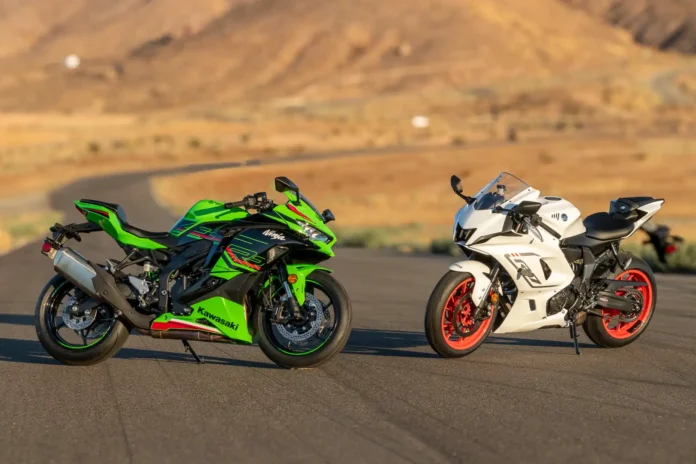
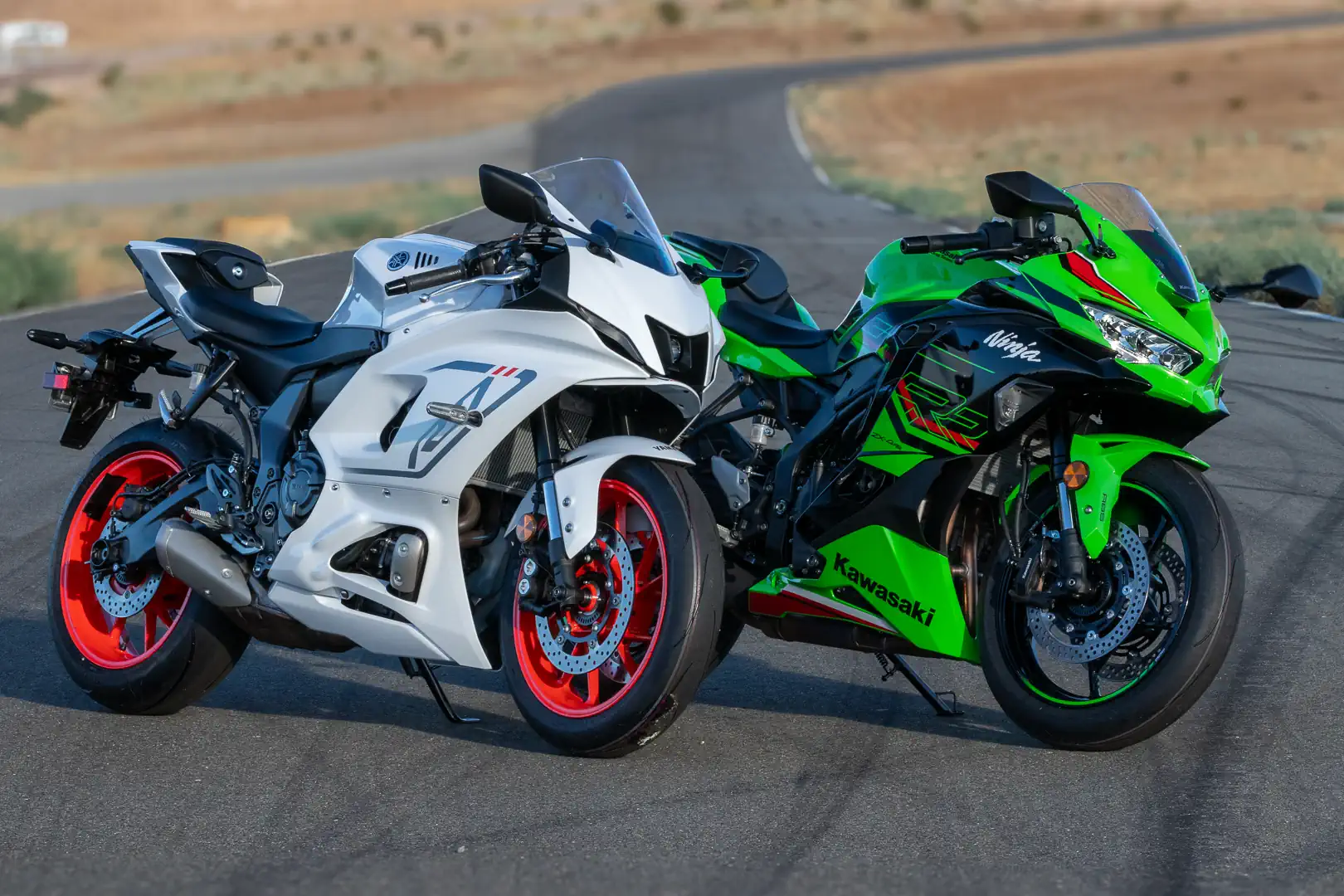
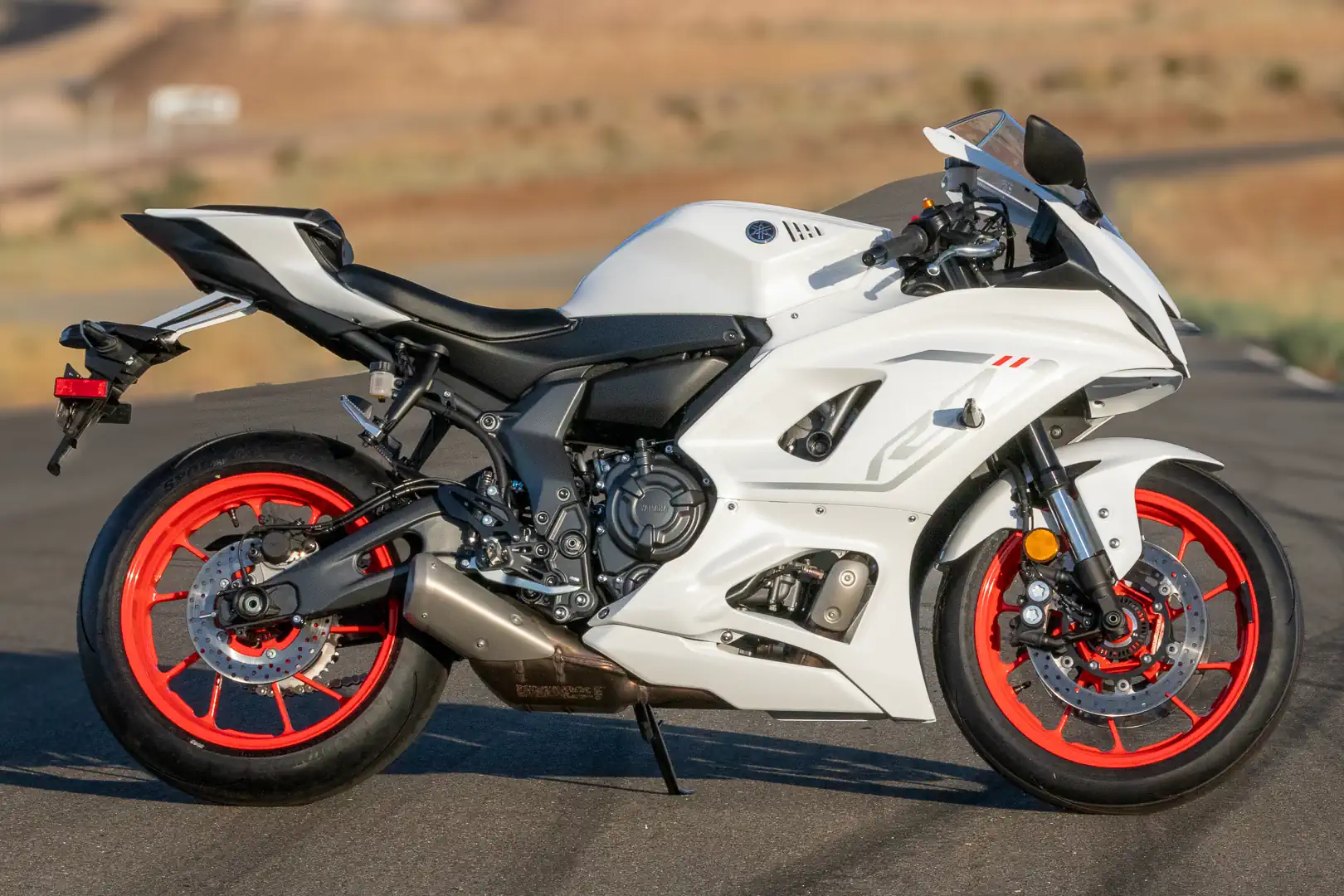
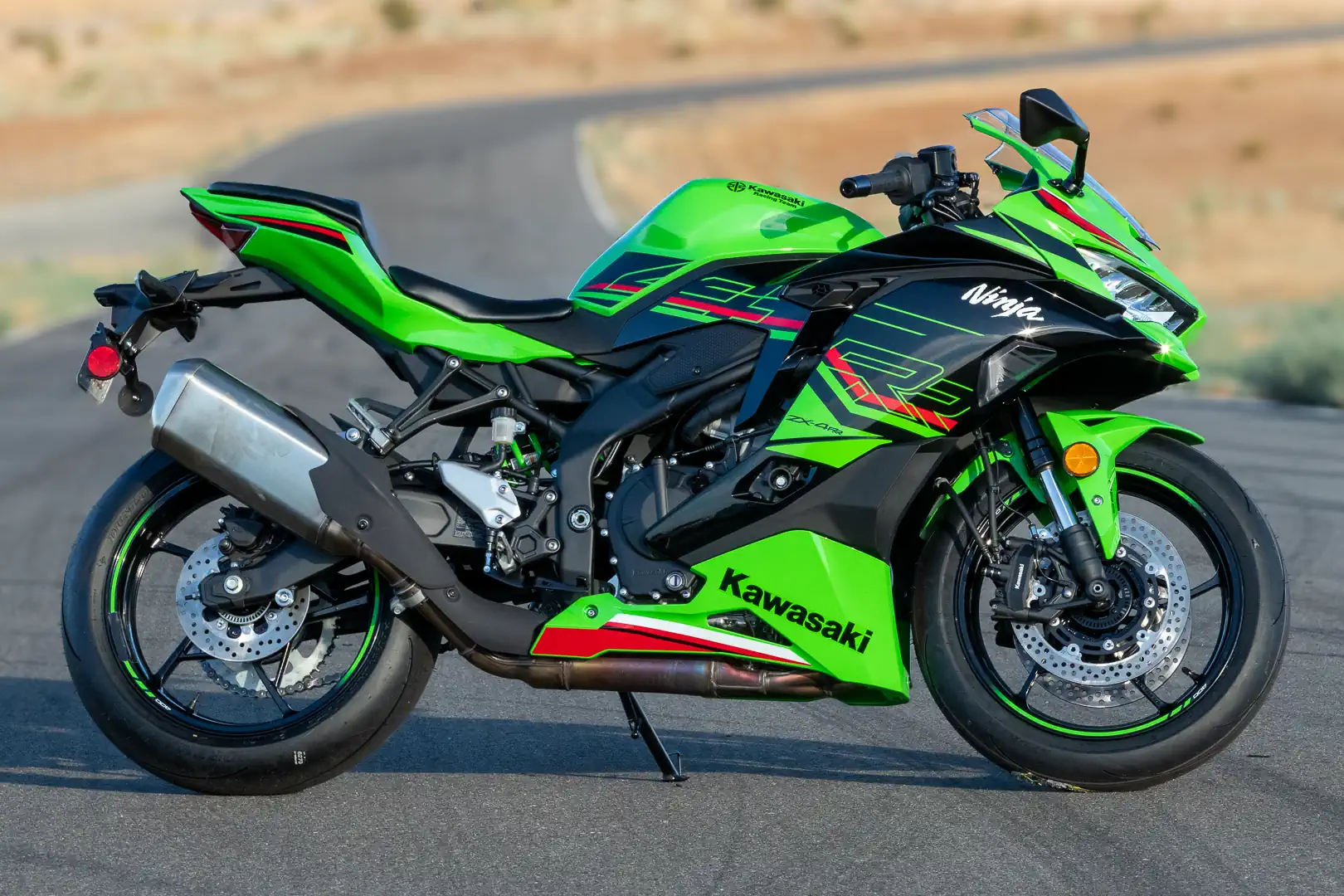
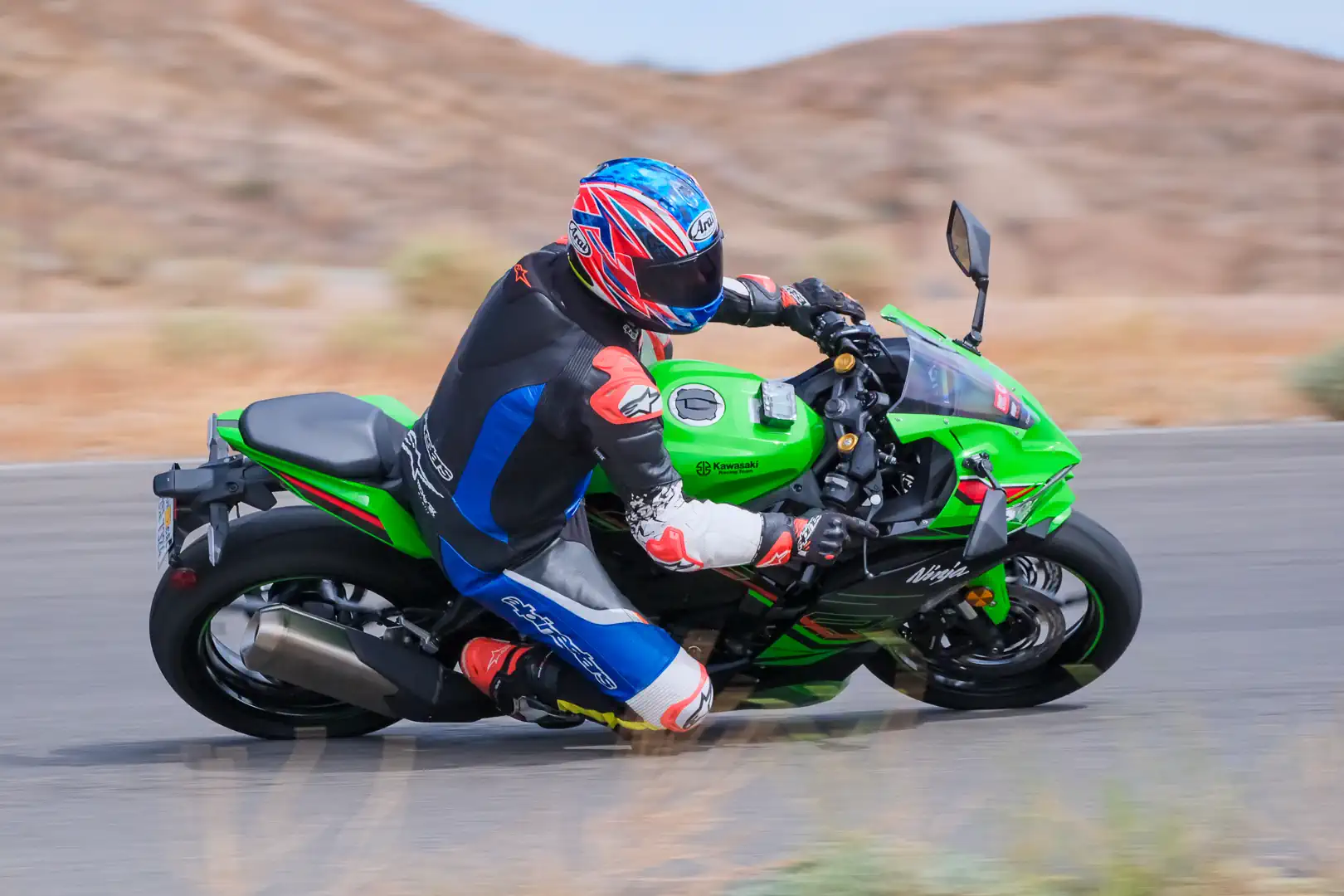
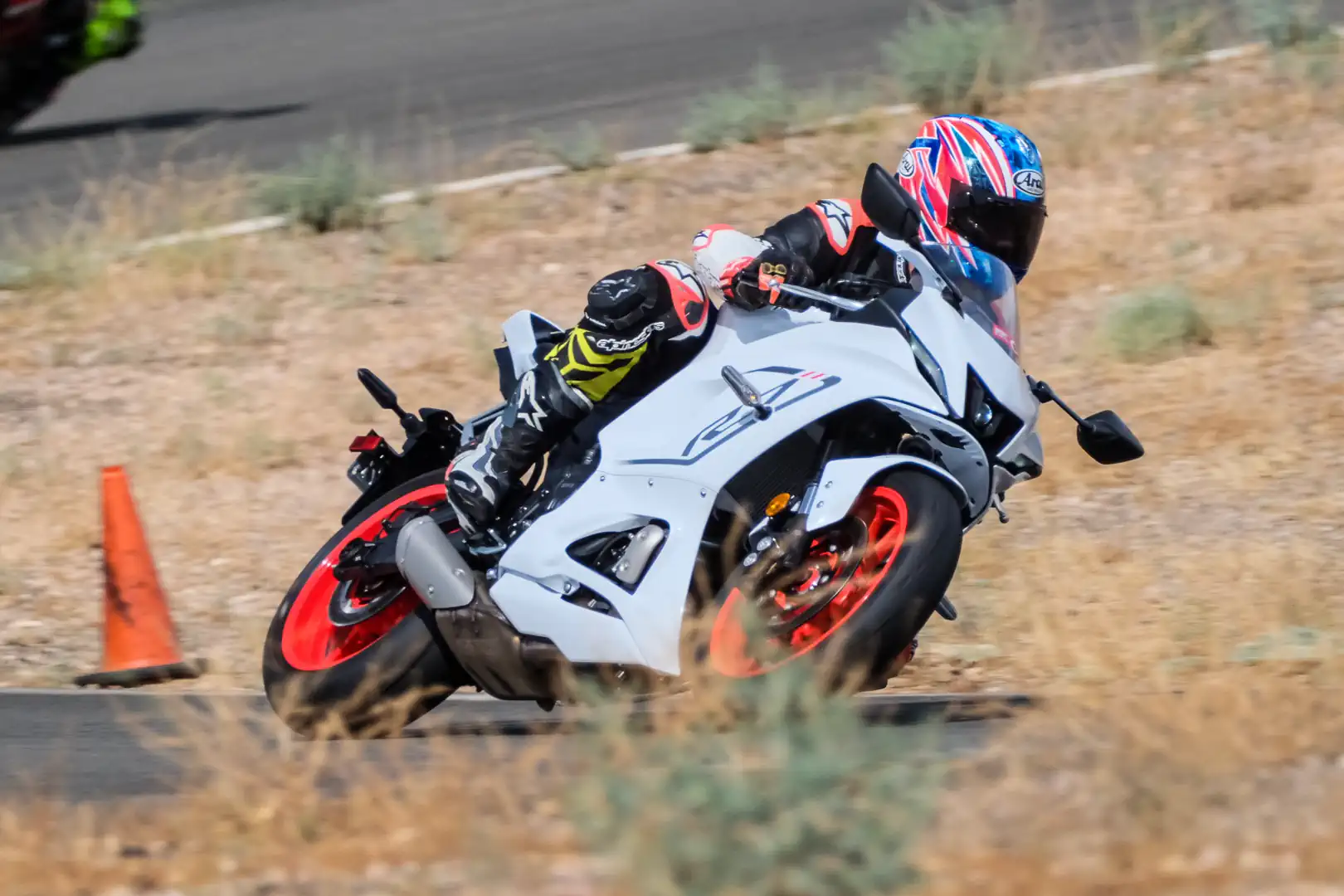
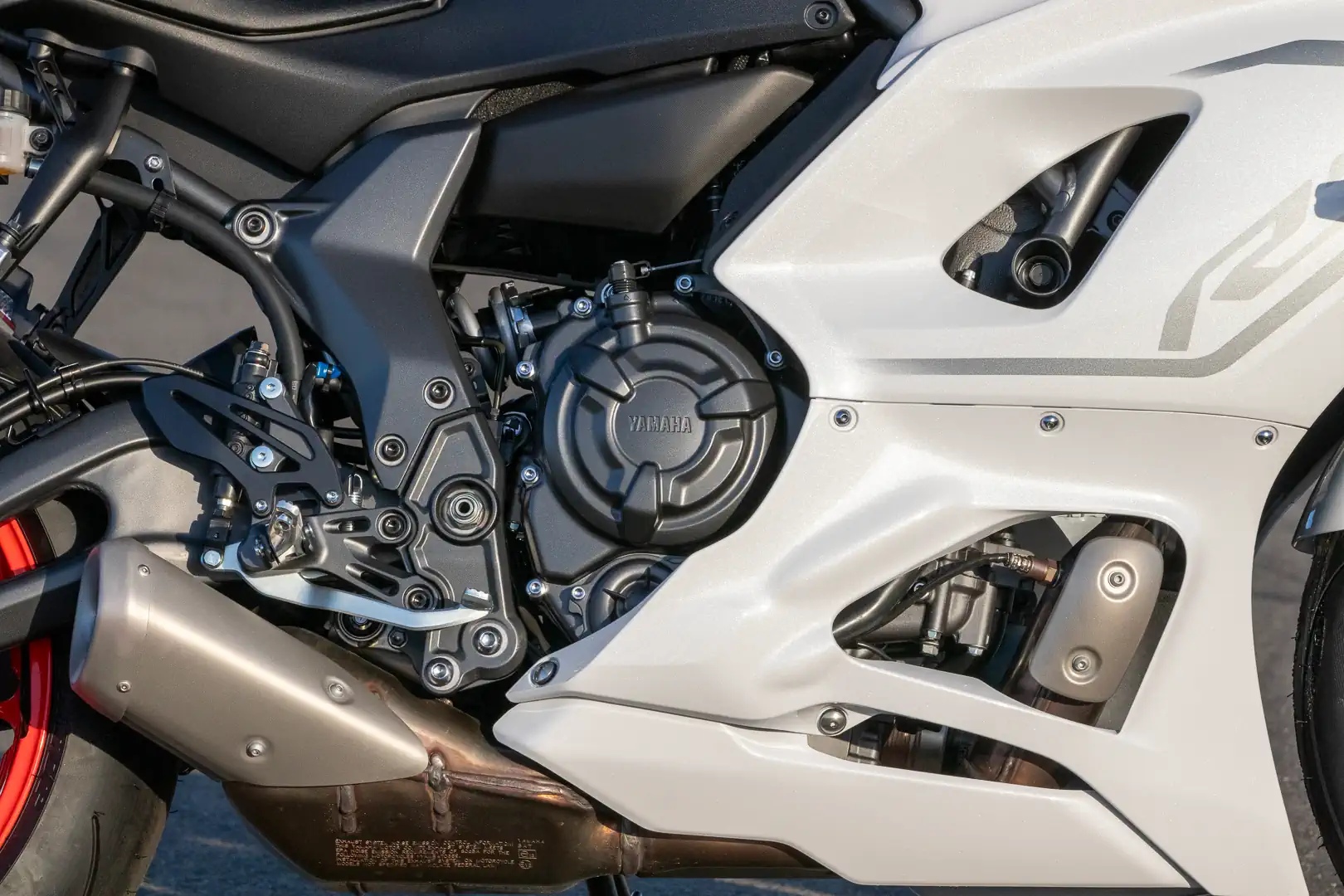
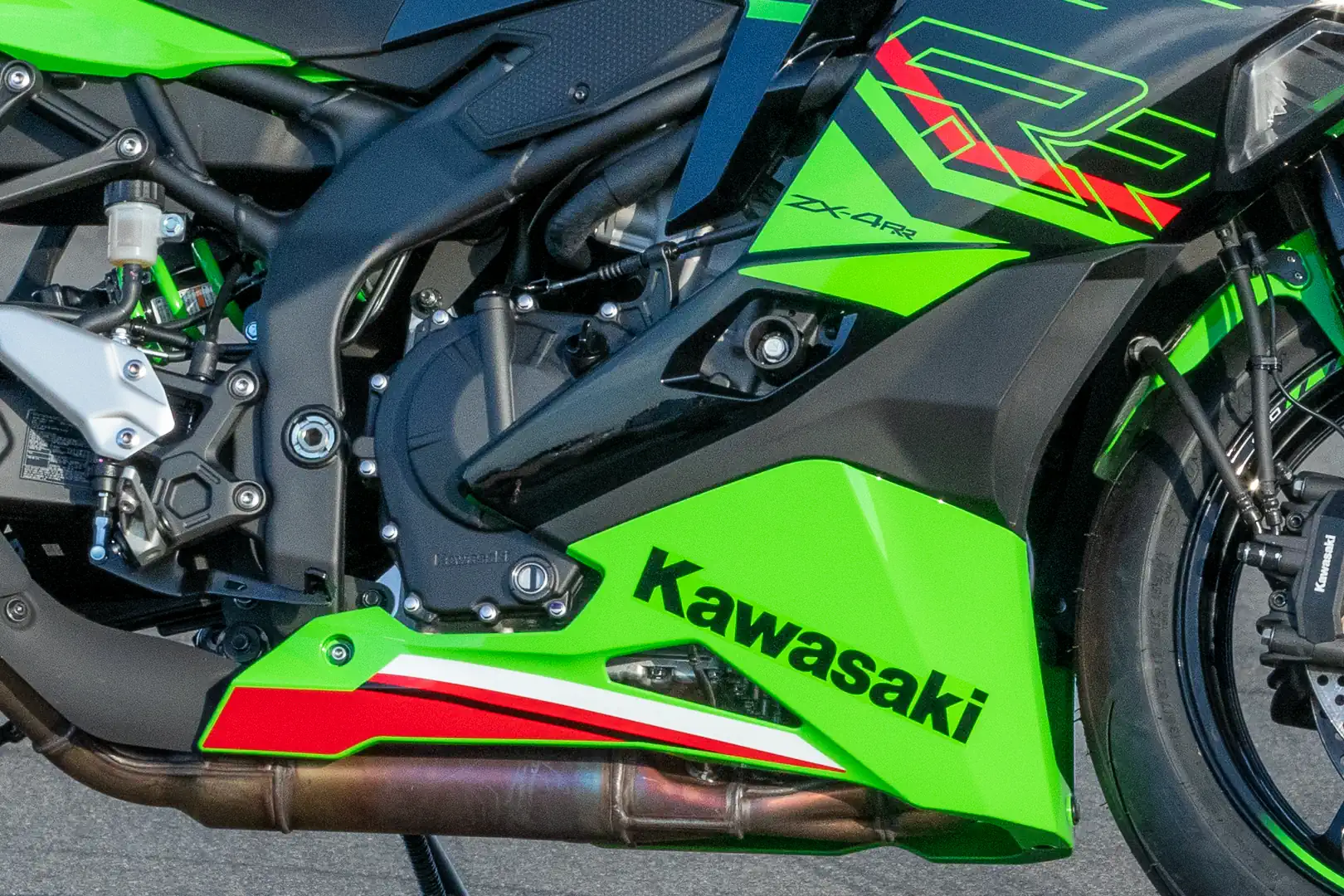
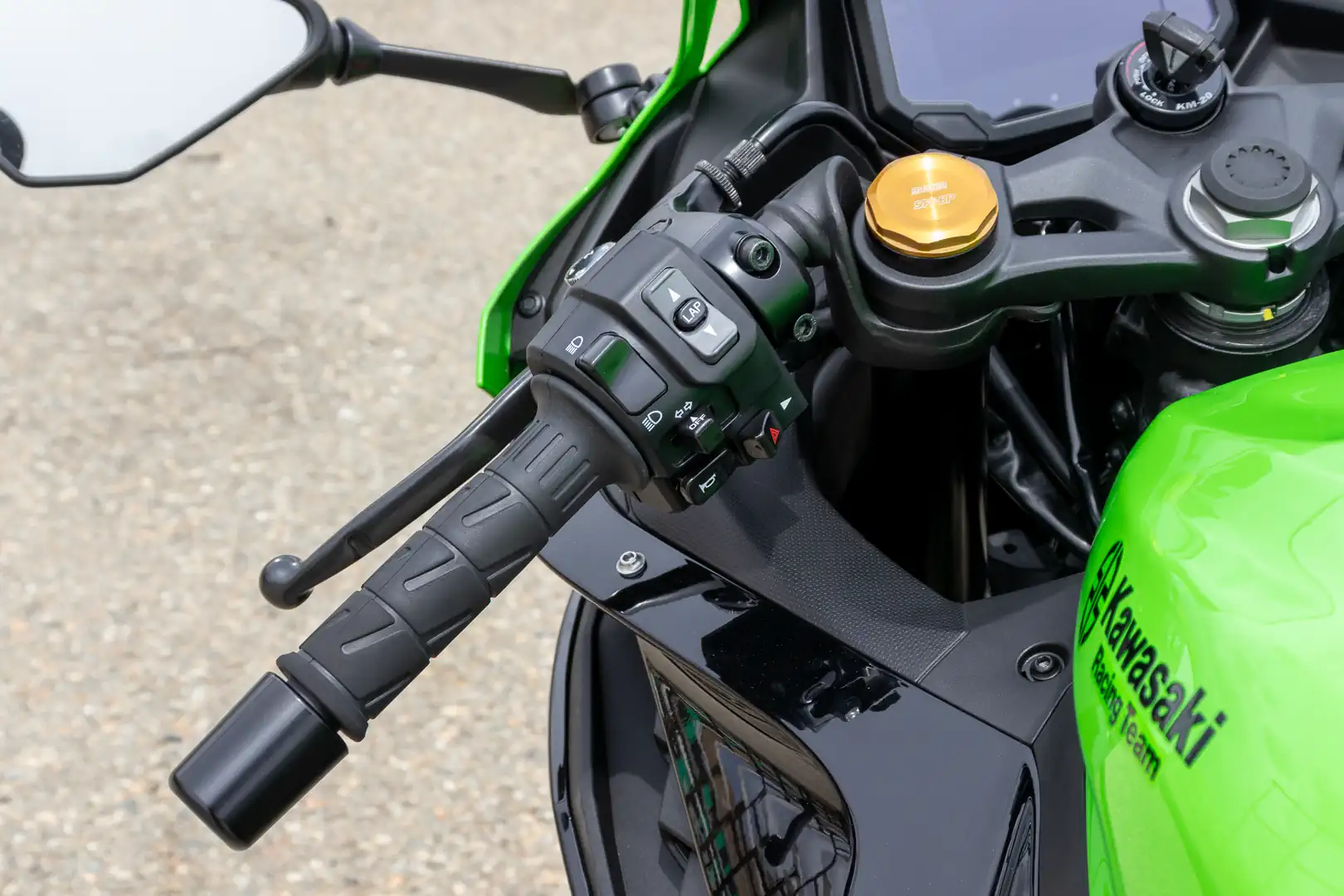
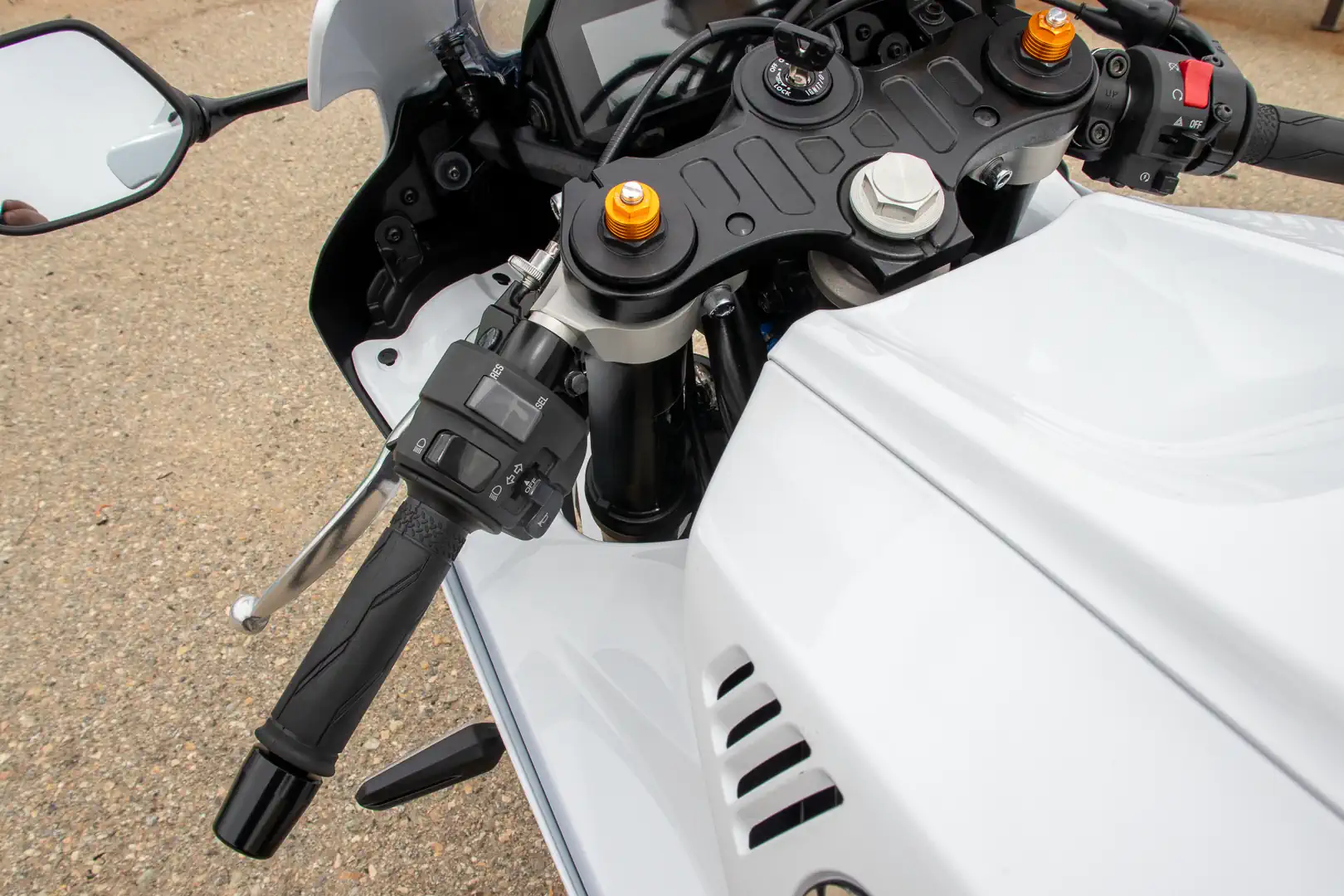
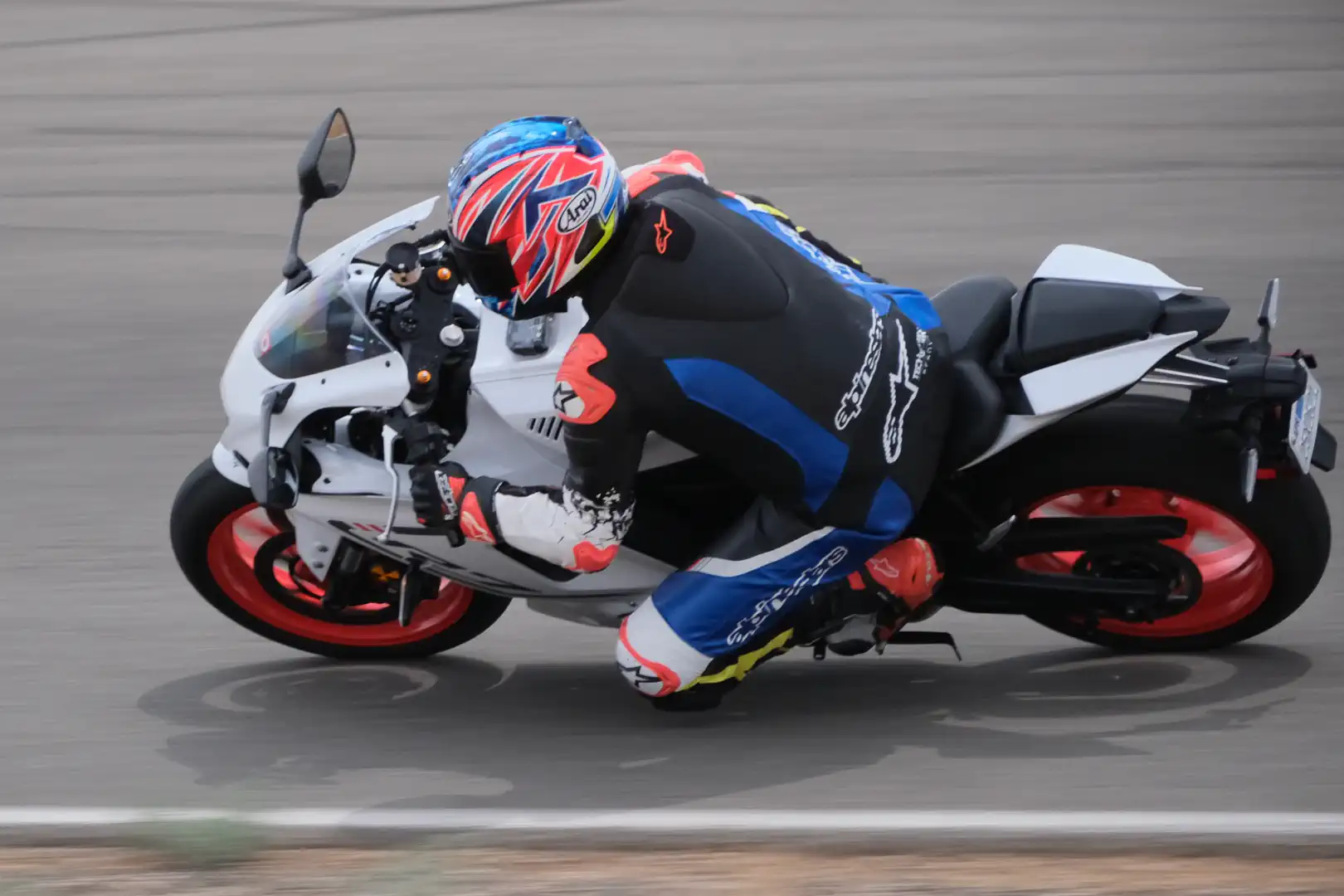
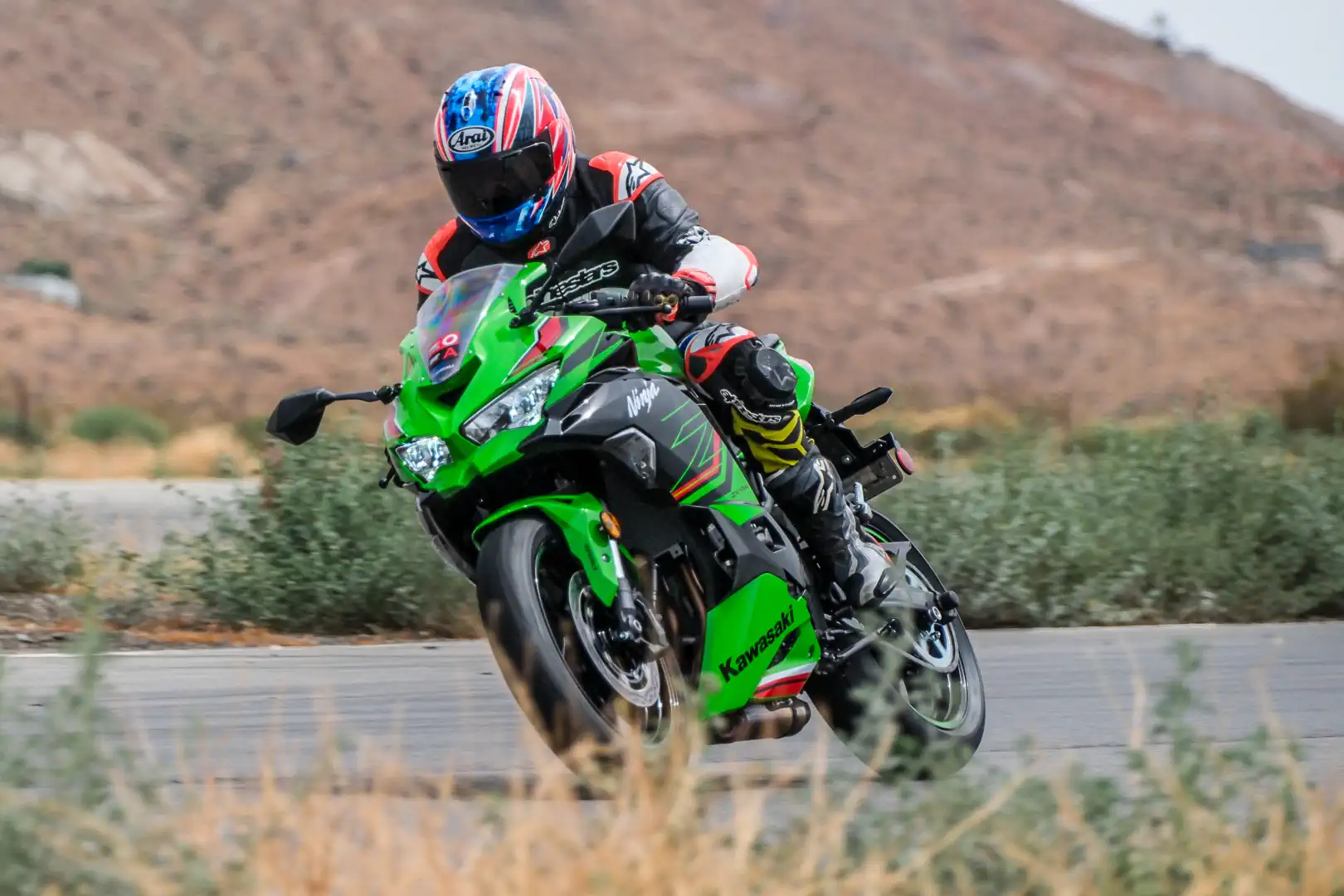
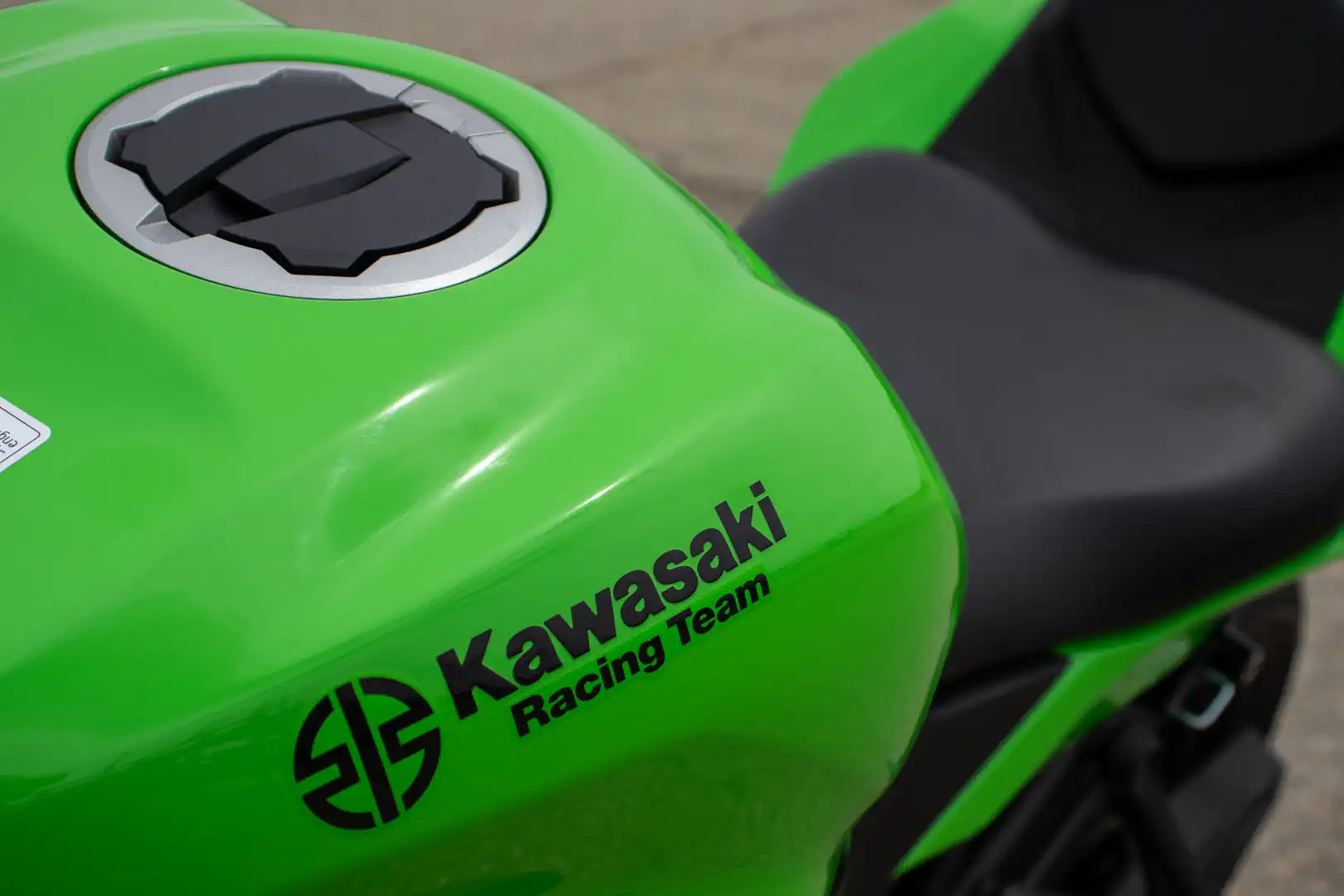
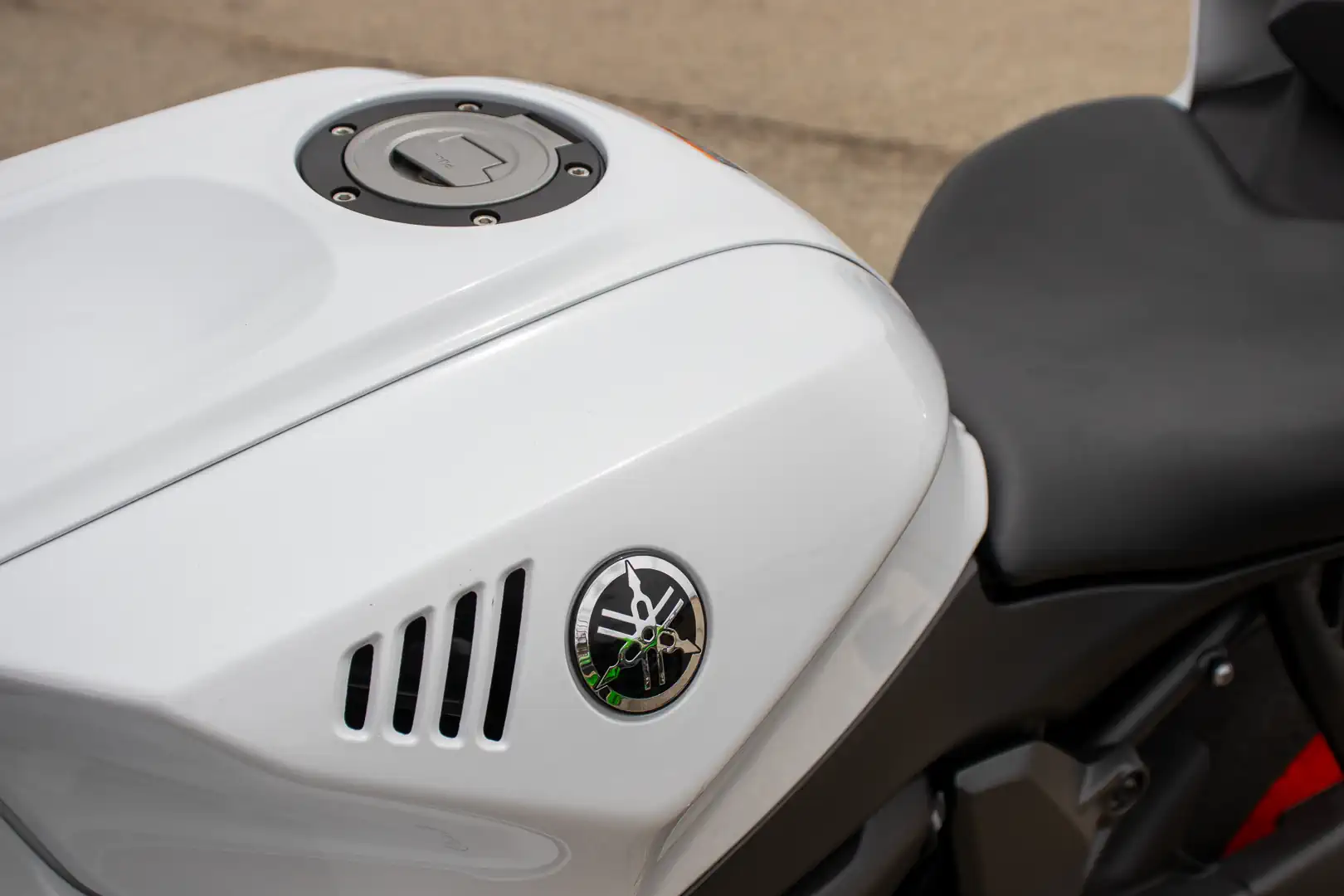
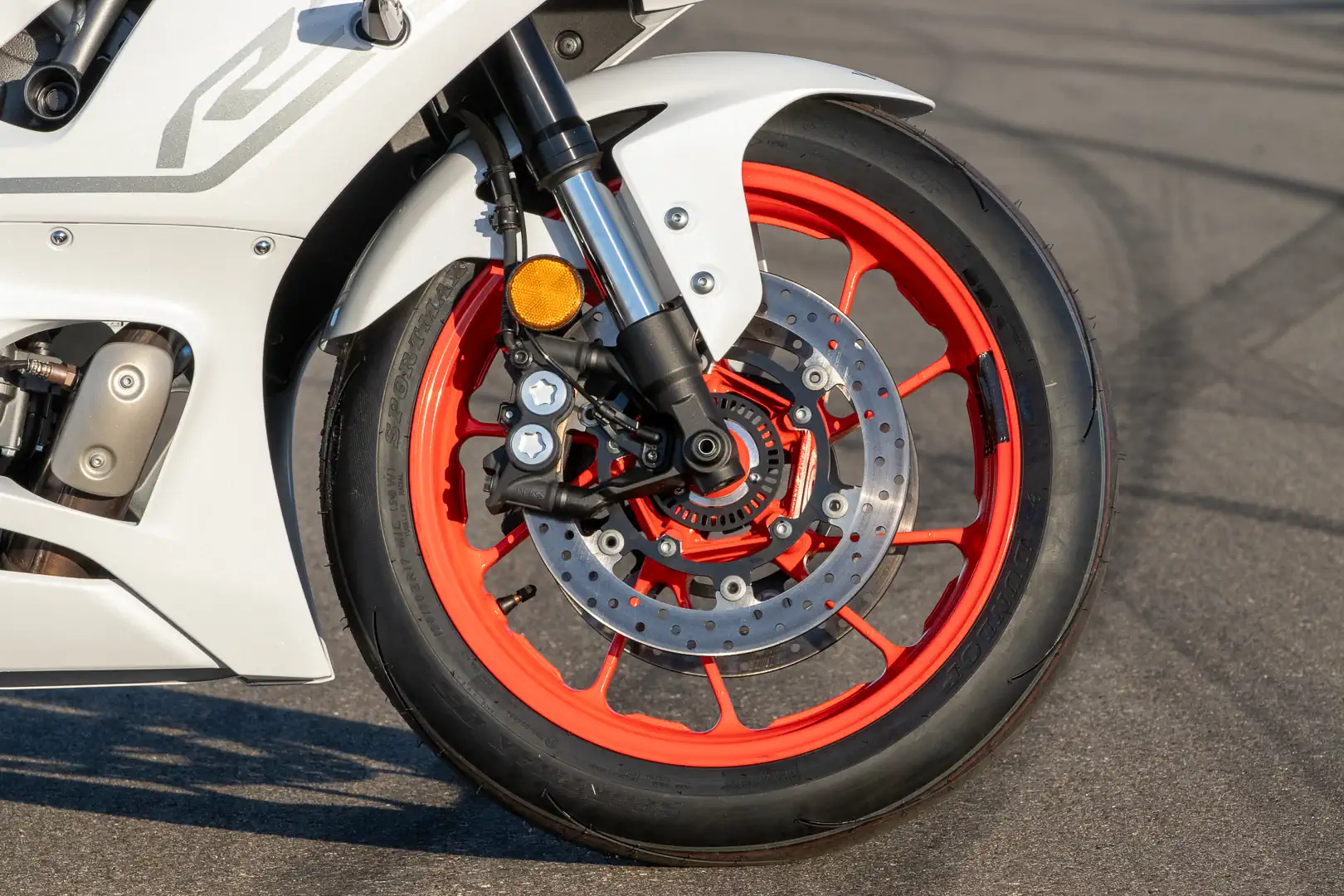
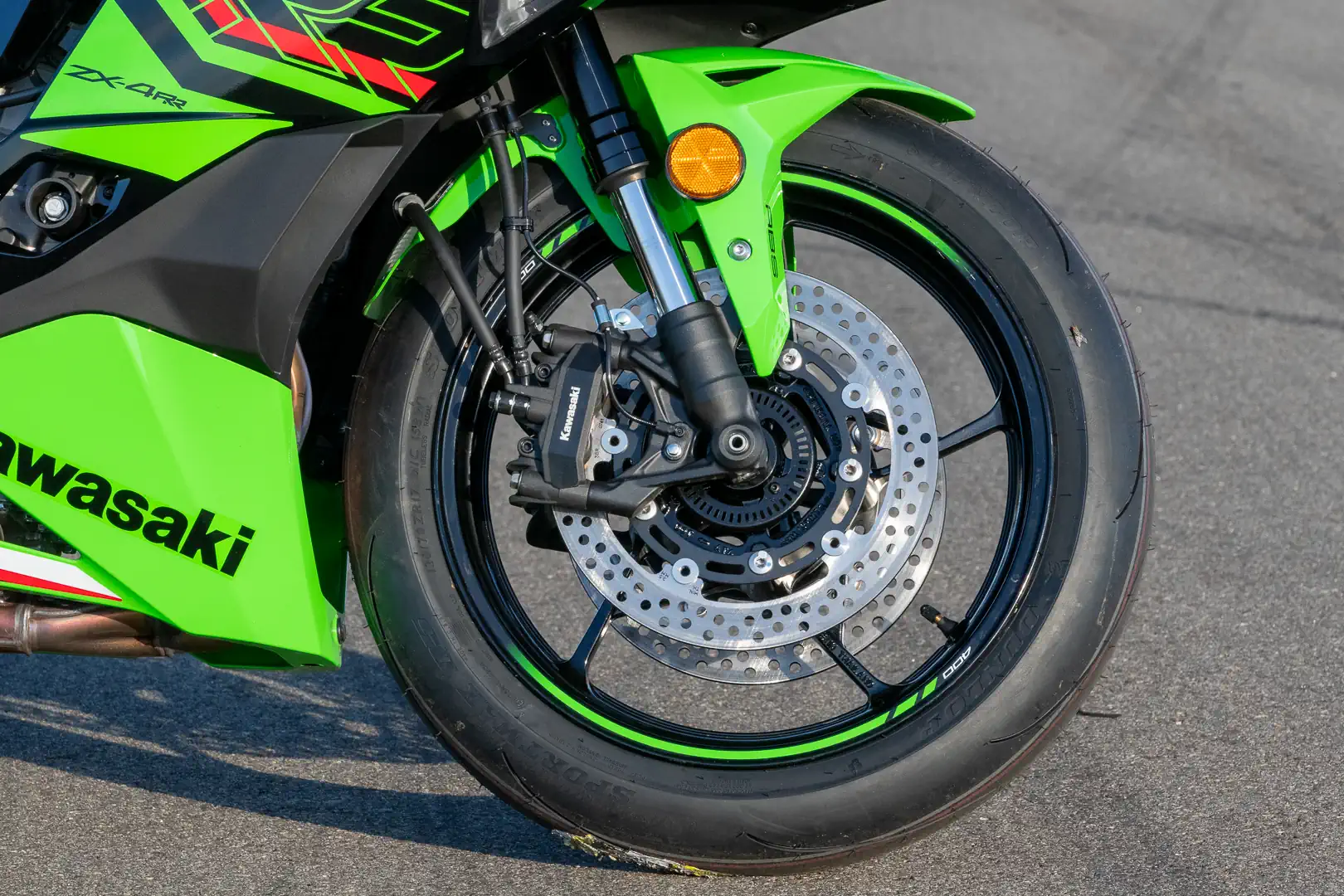
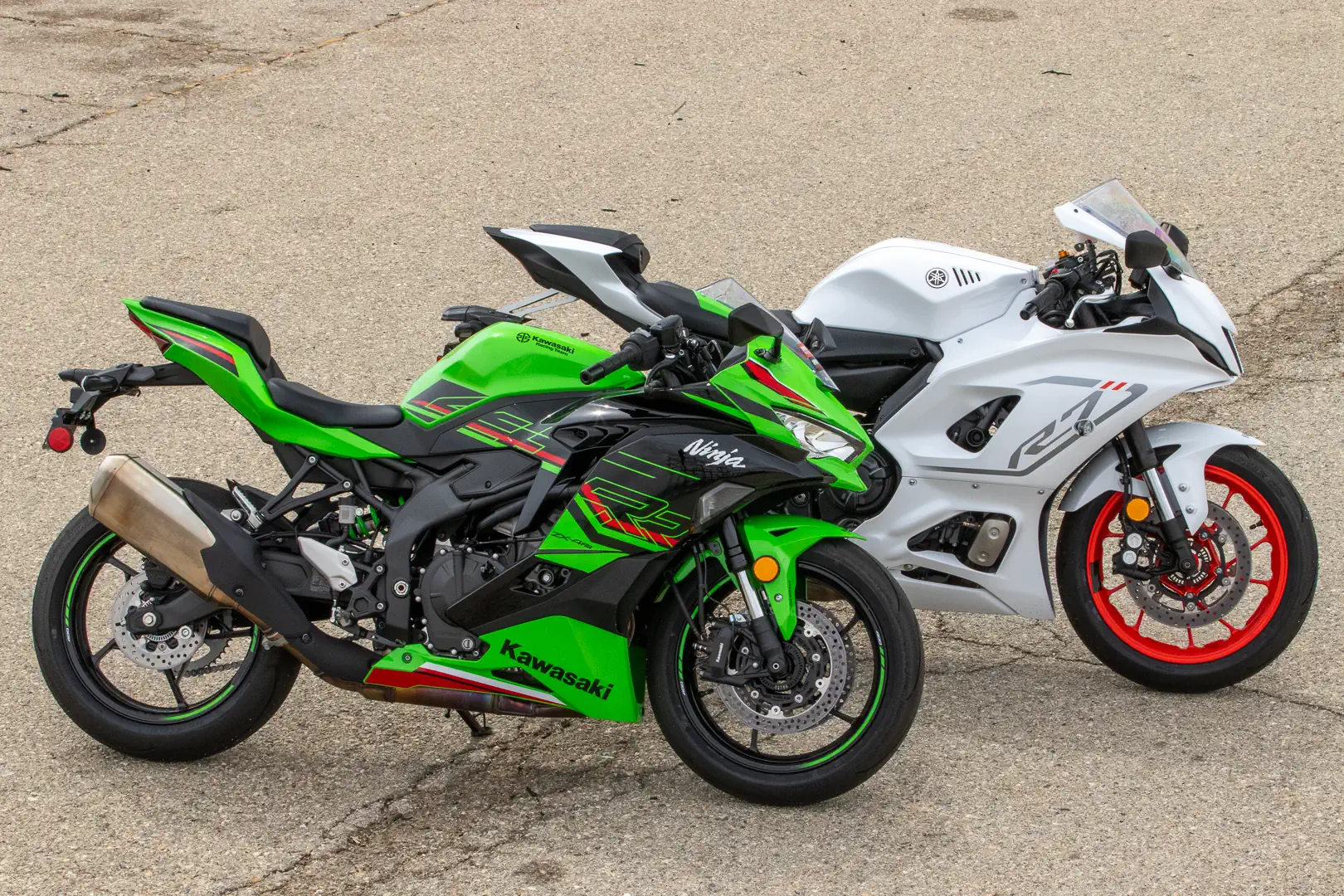
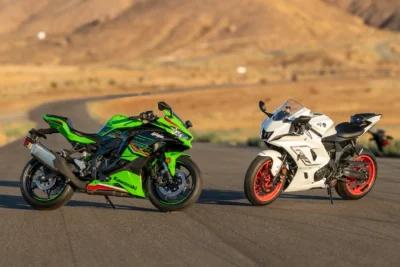
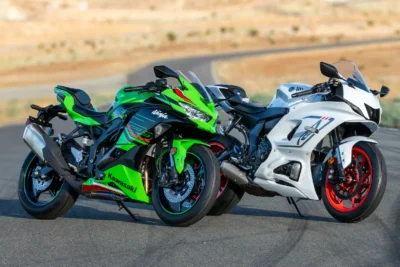
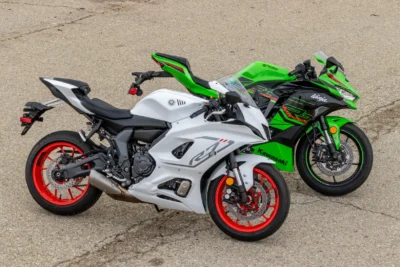
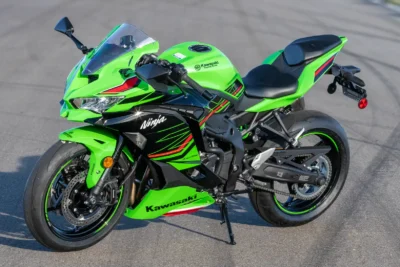
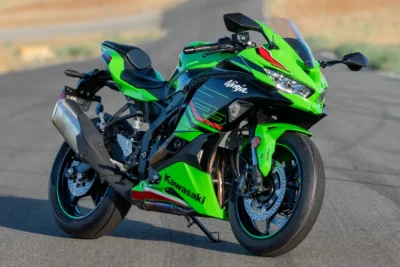
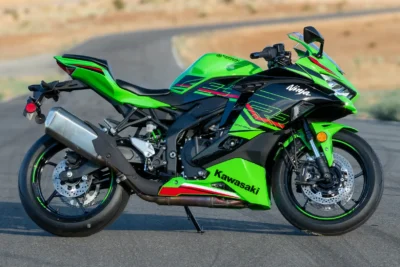
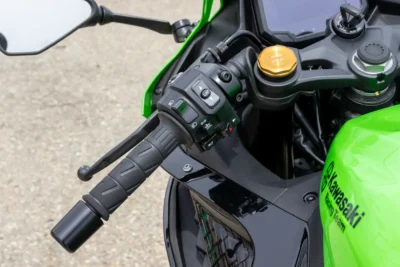
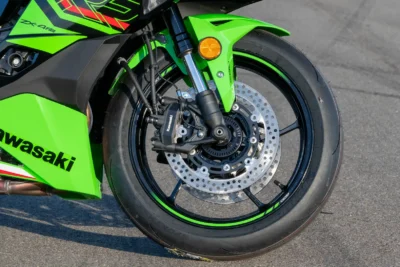
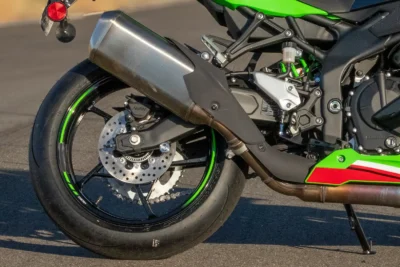
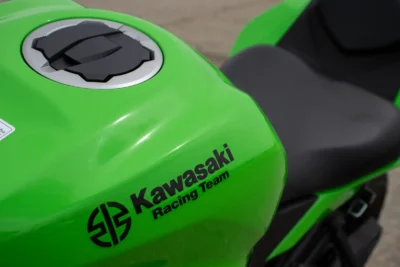
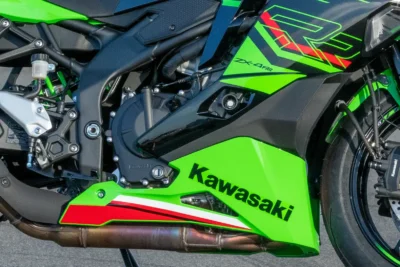
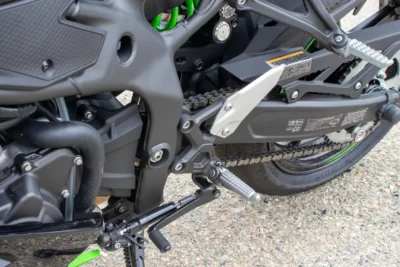
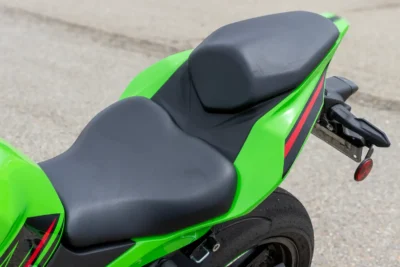
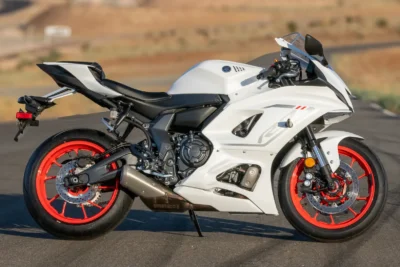
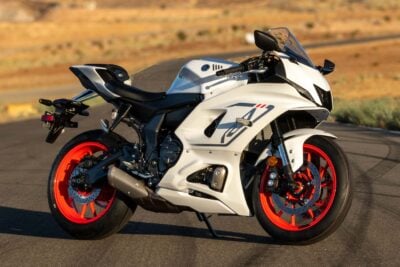
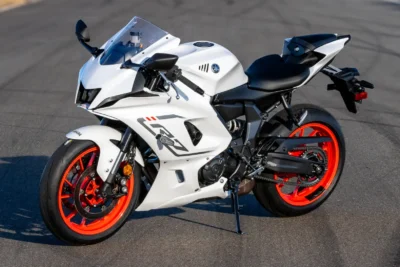
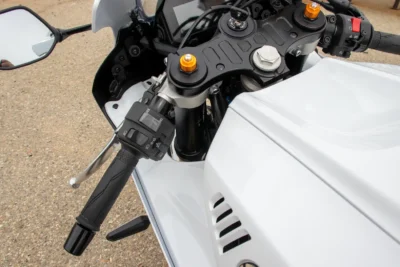
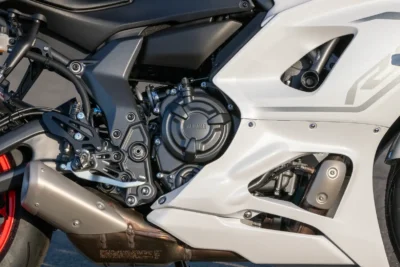
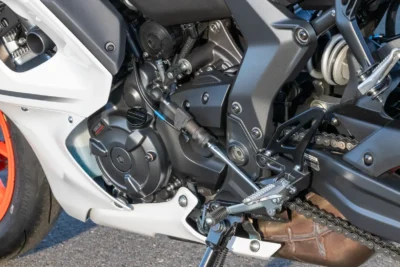
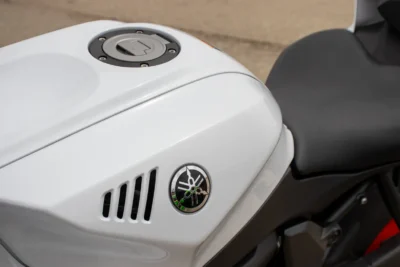
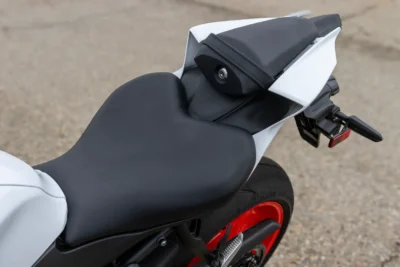
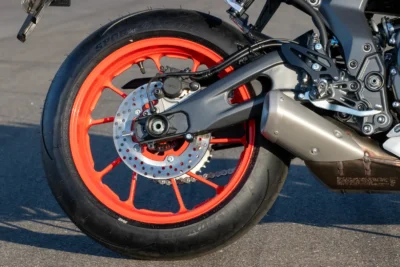
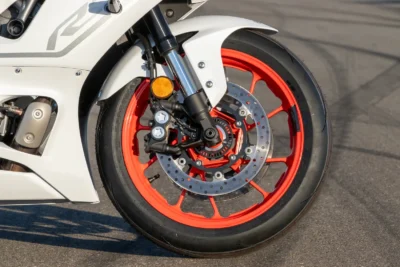
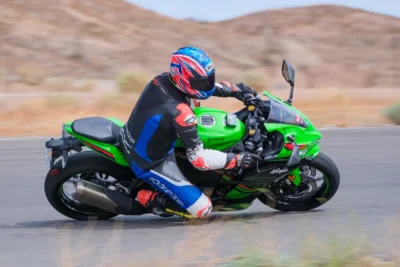
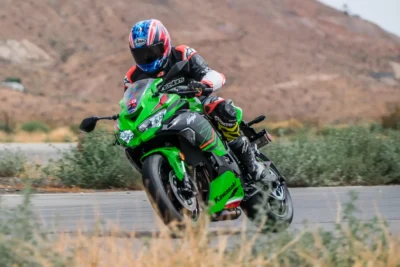
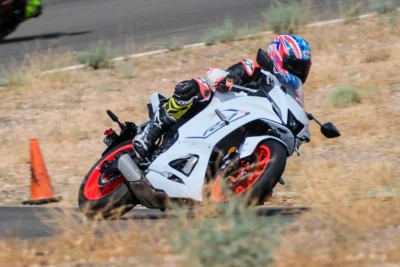
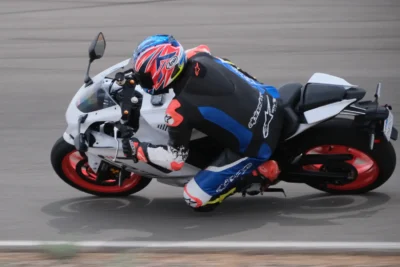
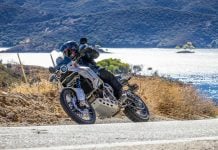
![2023 KTM 390 Adventure Review [15 Fast Facts] 2023 KTM 390 Adventure Review: For Sale](webp/2023-ktm-390-adventure-review-24-218x150.webp)
![2023 Kawasaki KLR650 S ABS Review [15 Fast Facts]](webp/2023-kawasaki-klr650-s-review-dual-sport-adventure-motorcycle-14-218x150.webp)
